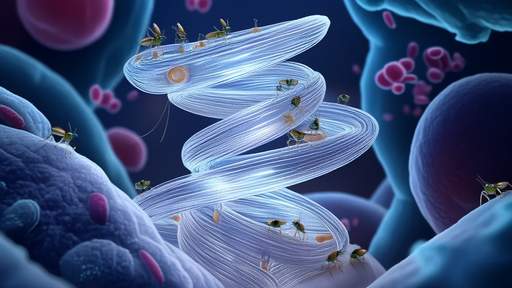The Black Death, one of the most devastating pandemics in human history, swept through medieval Europe in the mid-14th century, claiming the lives of at least 25 million people within just five years. This catastrophic event was caused by the bacterium *Yersinia pestis*, a pathogen that has plagued humanity for over 5,000 years. Despite its deadly reputation, the plague did not disappear after the Black Death; instead, it adapted to survive and continue infecting humans for centuries. Recent research published in the journal *Science* has shed light on how *Y. pestis* evolved to persist among human populations, providing crucial insights into the bacterium's adaptive strategies.
The Plague's Evolutionary Journey
*Yersinia pestis* has been responsible for three major plague pandemics: the Plague of Justinian (AD 541-544), the Black Death (1347-1352), and the Third Pandemic, which began in China in the 1850s and continues to this day. Although the deadliest years of the plague are behind us, the disease still occurs sporadically in parts of Asia, South America, the United States, and more frequently in Africa. Modern cases of plague can be treated with antibiotics, but understanding how *Y. pestis* evolved and dispersed remains a critical area of research.
The Role of the Pla Gene
A key factor in the persistence of the plague lies in the bacterium's genetic makeup. Recent analysis of ancient and modern *Y. pestis* samples revealed that changes to a single gene, known as *pla*, played a crucial role in the bacterium's adaptability. The *pla* gene encodes an enzyme that interacts with host proteins, breaking down blood clots and facilitating the spread of *Y. pestis* into the host's lymph nodes, where it replicates before attacking the rest of the body.
In the early stages of plague pandemics, the disease was highly lethal, killing infected individuals within three days. However, over time, *Y. pestis* evolved to become less deadly and more transmissible. This adaptation allowed the bacterium to survive longer in its hosts, increasing the chances of transmission to new hosts. The study found that strains of *Y. pestis* with fewer copies of the *pla* gene emerged about 100 years after the initial pandemics. These weakened strains had a higher survival rate in experimental mice, taking about two days longer to kill their hosts compared to strains with a normal amount of the *pla* gene.
The Persistence of the Plague
The persistence of the plague over centuries can be attributed to these adaptive changes. In the early stages of a pandemic, infections were rapid and deadly for both rats and humans. As rat populations thinned out, selective pressures favored the emergence of less deadly strains of *Y. pestis*. These strains, with fewer copies of the *pla* gene, allowed infected rats to live longer, enabling them to spread the disease to more rats and humans.
This evolutionary strategy led to what researchers call an "epidemic burnout" about 100 years after a bubonic plague outbreak. Mathematical models suggest that the emergence of these less deadly strains allowed the plague to continue circulating in human populations, even after the initial wave of high mortality had subsided.
Modern Implications
Understanding the adaptive strategies of *Y. pestis* has significant implications for managing modern plague outbreaks. The findings suggest that the bacterium's ability to evolve and persist in human populations could inform strategies for controlling and preventing future outbreaks. By studying the genetic changes in *Y. pestis*, researchers can better understand how the bacterium adapts to new environments and hosts, providing valuable insights into the transmission patterns of modern plague cases.
The Study's Methodology
For the study, scientists collected ancient samples of *Y. pestis* from human remains dating back to about 100 years after the appearance of the first and second plague pandemics. These samples were taken from various locations, including Denmark, Europe, and Russia. The researchers reconstructed the genomes of these ancient plague strains and compared them with older strains dating back to the start of the pandemics. They also examined over 2,700 genomes of modern plague samples from Asia, Africa, and North and South America.
The study's co-lead author, Ravneet Sidhu, a doctoral student at McMaster University in Ontario, Canada, explained that the reconstructed genomes showed fewer copies of the *pla* gene. This finding was corroborated by experiments on mice, which demonstrated higher survival rates in those infected with strains of *Y. pestis* with reduced *pla* genes.
Future Research Directions
The study's findings open new avenues for future research. By bridging the gap between ancient and modern data, researchers can gain a deeper understanding of the plague's evolutionary history. This interdisciplinary approach could help uncover other adaptive strategies employed by *Y. pestis* and provide insights into the persistence of other infectious diseases.
Dr. Deborah Anderson, a professor of veterinary pathobiology at the University of Missouri, emphasized the importance of these findings for understanding modern plague transmission. Anderson, who was not involved in the study, noted that her laboratory investigates the flea-rodent cycle and conducts field research in areas experiencing plague outbreaks. "After reading this paper, we will pay closer attention to Pla in the future to see if there continues to be a role for its expression in driving the explosive outbreaks of plague in animal populations," she said.
The plague, caused by *Yersinia pestis*, has left an indelible mark on human history. Its ability to adapt and persist over centuries is a testament to the bacterium's evolutionary resilience. By understanding how *Y. pestis* evolved to become less deadly and more transmissible, researchers can better prepare for and manage modern plague outbreaks. The findings from this study not only shed light on the past but also provide valuable insights into the future of infectious diseases. As scientists continue to explore the adaptive patterns of pathogens, they gain crucial knowledge to combat and control the spread of diseases like plague and, potentially, future pandemics.

By Daniel Scott/Jun 6, 2025

By John Smith/Jun 6, 2025

By Daniel Scott/Jun 6, 2025

By Emma Thompson/Jun 6, 2025

By Sophia Lewis/Jun 6, 2025

By Olivia Reed/Jun 6, 2025

By Joshua Howard/Jun 6, 2025

By David Anderson/Jun 6, 2025

By Emma Thompson/Jun 6, 2025

By Emily Johnson/Jun 6, 2025

By Samuel Cooper/Jun 6, 2025

By Emily Johnson/Jun 6, 2025

By Sophia Lewis/Jun 6, 2025

By Jessica Lee/Jun 6, 2025